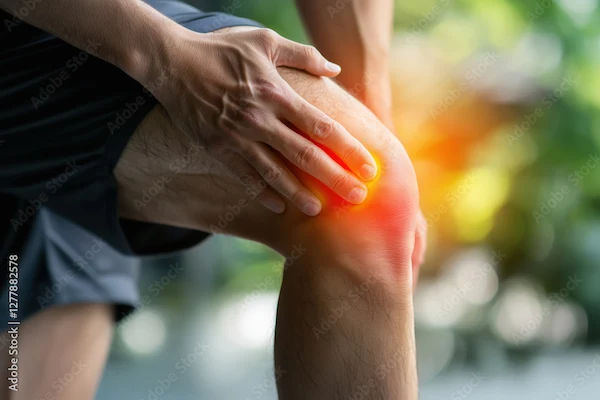Bursitis: Understanding Its Causes, Symptoms, and Treatment Options
Understanding bursitis: its causes, symptoms, and treatment options. Learn how to manage joint pain and find relief from bursitis inflammation.

Written by Dr.Sonia Bhatt
Last updated on 3rd Jul, 2025

Bursitis—though it may not be a term you hear every day—can be a real pain, quite literally. If you've ever experienced discomfort around your joints, you might have unknowingly been dealing with bursitis. This condition occurs when the bursae, small, fluid-filled sacs that cushion and protect the joints, become inflamed. The result? Swelling, tenderness, and sometimes even sharp pain that can make everyday activities, like walking or lifting, feel like a challenge. Whether you’re an athlete, a manual labourer, or just someone going about their daily routine, bursitis can disrupt your life. In this article, we’ll help you understand what bursitis is, what causes it, how to spot the symptoms, and most importantly, how to manage and treat it effectively.
What is Bursitis?
Bursitis occurs when the bursae, small, fluid-filled sacs located around joints, become inflamed. These bursae act as cushions between your bones and the tendons or muscles that surround them, helping to reduce friction and ease movement. When they become irritated or inflamed, it leads to bursitis.
Although bursitis can develop in any joint, it most commonly affects the shoulders, elbows, hips, and knees. The condition can vary in severity, with symptoms ranging from mild discomfort to severe pain that limits movement.
Causes of Bursitis
Bursitis is usually caused by repetitive motions, pressure, or injury. However, other factors may contribute to its development. Let’s explore some of the most common causes:
Repetitive Motion
Activities that involve repeated movements or putting prolonged pressure on a joint can increase the likelihood of developing bursitis. For example, repetitive actions in sports, like tennis or golf, or tasks such as gardening, painting, or playing musical instruments can irritate the bursae, leading to inflammation.
Prolonged Pressure
If you spend a lot of time kneeling, sitting on hard surfaces, or placing continuous pressure on a joint, you may be at risk. For example, housemaids' knees, which affect the knee, are common in individuals who kneel often. Similarly, carpet layers or plumbers may develop bursitis in the knees or elbows from kneeling on hard surfaces for extended periods.
Injury or Trauma
An injury or sudden trauma, such as a fall, bump, or direct impact on a joint, can cause inflammation in the bursa. It’s not uncommon for athletes or people engaged in manual labour to experience bursitis due to trauma.
Infection (Septic Bursitis)
Sometimes, bursitis can be caused by an infection in the bursa, known as septic bursitis. This happens when bacteria enter the bursa, often through a cut, scrape, or other skin injury. Septic bursitis typically affects bursae close to the surface of the skin, like those in the elbows or knees. It’s important to seek medical care quickly if you suspect you have septic bursitis, as it can lead to more serious complications if left untreated.
Underlying Medical Conditions
Certain health conditions can increase the risk of developing bursitis, including:
Rheumatoid arthritis: An autoimmune condition causing inflammation in the joints.
Gout: A form of arthritis caused by uric acid crystals that can irritate the bursae.
Diabetes: Increases the risk of joint-related issues, including bursitis.
Obesity: Extra body weight puts added pressure on joints, contributing to bursitis, especially in the hips and knees.
Symptoms of Bursitis
The symptoms of bursitis vary depending on which joint is affected, but common signs include:
Pain: Pain often starts as a dull ache and becomes more intense, especially with movement or pressure on the affected joint. It may worsen when you engage in repetitive actions or activities that strain the joint.
Swelling: You may notice swelling around the affected joint. The bursa becomes inflamed and filled with fluid, making the area feel puffy or swollen.
Stiffness: Limited range of motion and stiffness in the affected joint are hallmark symptoms. You might find it difficult to move the joint fully, especially after periods of rest.
Tenderness: The area around the bursa can become sensitive to touch. Even light pressure might be painful.
Redness and Warmth: In some cases, particularly with septic bursitis or severe inflammation, the skin over the affected joint may become red and feel warm to the touch.
Diagnosing Bursitis
To diagnose bursitis, your healthcare provider will typically begin with a physical examination, during which they will assess your symptoms, check for swelling, tenderness, and restricted movement, and ask about your activities and any recent injuries.
If needed, additional tests may include:
Imaging Tests: X-rays, ultrasound, or MRI may be used to rule out other conditions and confirm the diagnosis.
Aspiration: If an infection is suspected, the doctor may use a needle to withdraw fluid from the bursa. This fluid can then be tested to check for infection.
Treatment Options for Bursitis
The main goal in treating bursitis is to reduce inflammation and relieve pain. Treatment often starts with conservative measures, but in more severe cases, additional interventions may be required.
1. Rest and Activity Modification
Rest is key. Giving the affected joint time to heal is essential, and avoiding activities that worsen the symptoms will help prevent further irritation. If your job or activities require repetitive motions, try to reduce strain on the joint as much as possible.
2. Ice and Heat Therapy
Ice: Applying an ice pack to the affected joint can reduce inflammation and numb the pain. Ice therapy is most effective within the first 48 hours of symptoms.
Heat: After the initial inflammation has subsided, applying heat can help relax the muscles and improve circulation around the joint.
3. Medications
Nonsteroidal Anti-Inflammatory Drugs (NSAIDs): Over-the-counter NSAIDs like ibuprofen or naproxen can reduce pain and swelling. They are often used to treat acute bursitis.
Corticosteroid Injections: If your bursitis is severe or chronic, a doctor might recommend corticosteroid injections directly into the bursa. These injections can offer quick relief from inflammation and pain.
4. Physical Therapy
Physical therapy plays a crucial role in recovery. A physical therapist can guide you through exercises that strengthen the muscles surrounding the affected joint, improve your range of motion, and reduce the likelihood of flare-ups in the future.
5. Aspiration and Drainage
In cases of septic bursitis or significant fluid accumulation, the doctor may need to drain the bursa through a procedure called aspiration. This can relieve pressure and help speed up recovery.
6. Surgery
While rarely necessary, surgery may be considered if bursitis does not respond to other treatments. A bursectomy involves the removal of the affected bursa. This is typically reserved for severe, chronic cases that don’t improve with conservative measures.
Consult Top Urologists
Home Remedies and Lifestyle Changes
Alongside medical treatments, there are steps you can take at home to manage bursitis:
Maintain a healthy weight: Excess weight can put additional stress on your joints, particularly in the hips and knees. A balanced diet and regular exercise can help alleviate this strain.
Stretching and Strengthening Exercises: Incorporating joint-friendly exercises into your daily routine can improve flexibility and muscle strength around the joint, reducing strain on the bursae.
Proper body mechanics: When lifting, bending, or performing repetitive tasks, use proper body mechanics and ergonomic tools to minimise strain on your joints.
Use protective gear: If your activities involve repetitive movements or putting prolonged pressure on certain joints, consider wearing knee pads, elbow pads, or other protective equipment to help reduce the risk of injury.
Preventing Bursitis
To prevent bursitis, it’s important to make some changes to your daily routine to reduce stress on your joints. Here are a few helpful tips:
Warm up before exercise: Make sure to warm up before exercising. This helps loosen your muscles and joints, preparing them for the activity and reducing the risk of injury.
Take frequent breaks: Avoid staying in the same position for too long or repeating the same motion. Give your joints a rest and stretch them regularly to prevent strain.
Use cushioning or padding: When kneeling or sitting for long periods, use cushions or knee pads to minimise pressure on your joints.
When to Seek Medical Attention
While mild bursitis often resolves with at-home care, you should consult a doctor if:
The pain is severe or doesn’t improve with rest and medications.
You experience sudden, sharp pain.
There is significant swelling, redness, or warmth around the joint.
You develop a fever, which may indicate an infection.
Symptoms persist despite treatment.
Conclusion
Bursitis is a common condition that can cause significant discomfort and affect your daily life. By understanding its causes, recognising the symptoms, and seeking appropriate treatment, you can manage bursitis effectively. With the right care, including lifestyle adjustments, preventive measures, and medical interventions, you can reduce the risk of recurrence and keep your joints healthy and pain-free.
If you suspect you have bursitis or if your symptoms persist, be sure to consult with a healthcare professional for a proper diagnosis and personalised treatment plan.
Consult Top Urologists
Consult Top Urologists

Dr. Sateesh Marriwada
Urologist
17 Years • MBBS, MS (General Surgery), Mch ( Genito Urinary Surgery)
Visakhapatnam
Apollo 24|7 Clinic - Andhra Pradesh, Visakhapatnam

Dr Tharaka Mourya Nutulapati
Urologist
7 Years • MBBS, MS (General Surgery), Mch ( Urology)
Visakhapatnam
Apollo 24|7 Clinic - Andhra Pradesh, Visakhapatnam

Dr. Sandeep Maheswara Reddy Kallam
Urologist
6 Years • MBBS, MS (General Surgery), M Ch (Genito-Urinary Surgery), Post Doctoral Fellowship in Uro-Surgical Oncology
Visakhapatnam
Dr. SANDEEP MAHESWARA REDDY K _- best Urologist in visakhapatnam, Visakhapatnam
(225+ Patients)

Dr. Prabir Basu
Urologist
19 Years • MBBS, MS General Surgery, DNB Genito-Urinary Surgery
Jodhpur Park
Dr. Prabir Basu urology clinic, Jodhpur Park
(125+ Patients)

Dr. Adittya K Sharma
Urologist
16 Years • MBBS MS MCH
Lucknow
Dr A K SHARMA, Lucknow
Consult Top Urologists

Dr. Sateesh Marriwada
Urologist
17 Years • MBBS, MS (General Surgery), Mch ( Genito Urinary Surgery)
Visakhapatnam
Apollo 24|7 Clinic - Andhra Pradesh, Visakhapatnam

Dr Tharaka Mourya Nutulapati
Urologist
7 Years • MBBS, MS (General Surgery), Mch ( Urology)
Visakhapatnam
Apollo 24|7 Clinic - Andhra Pradesh, Visakhapatnam

Dr. Sandeep Maheswara Reddy Kallam
Urologist
6 Years • MBBS, MS (General Surgery), M Ch (Genito-Urinary Surgery), Post Doctoral Fellowship in Uro-Surgical Oncology
Visakhapatnam
Dr. SANDEEP MAHESWARA REDDY K _- best Urologist in visakhapatnam, Visakhapatnam
(225+ Patients)

Dr. Prabir Basu
Urologist
19 Years • MBBS, MS General Surgery, DNB Genito-Urinary Surgery
Jodhpur Park
Dr. Prabir Basu urology clinic, Jodhpur Park
(125+ Patients)

Dr. Adittya K Sharma
Urologist
16 Years • MBBS MS MCH
Lucknow
Dr A K SHARMA, Lucknow